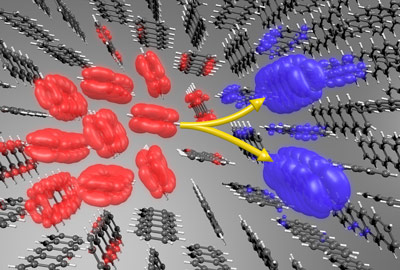
While there is a growing market for organic solar cells – they contain materials that are cheaper, more abundant, and more environmentally friendly than those used in typical solar panels – they also tend to be less efficient in converting sunlight to electricity than conventional solar cells.
Now, a team of Foundry staff and users who are members of the Center for Computational Study of Excited-State Phenomena in Energy Materials (C2SEPEM) a new energy materials-related science center based at Berkeley Lab, have solved a mystery that could lead to gains in efficiency.
They pinpointed the source of an ultrafast and efficient process that spawns several carriers of electrical charge from a single particle of light in organic crystals that are integral to this increasingly popular form of solar cells.
This process – called “singlet fission” because it is akin to the splitting of atomic nuclei in nuclear fission to create two lighter atoms from a heavier one – holds promise for dramatically boosting the efficiency of organic solar cells by rapidly converting more of sunlight’s energy to electrical charges instead of losing it to heat.
The research team found a new mechanism explaining how this reaction can occur in just tens of femtoseconds (quadrillionths of a second), before other competing effects can steal away their energy. Their study was published on Dec. 29 in the journal Physical Review Letters.

